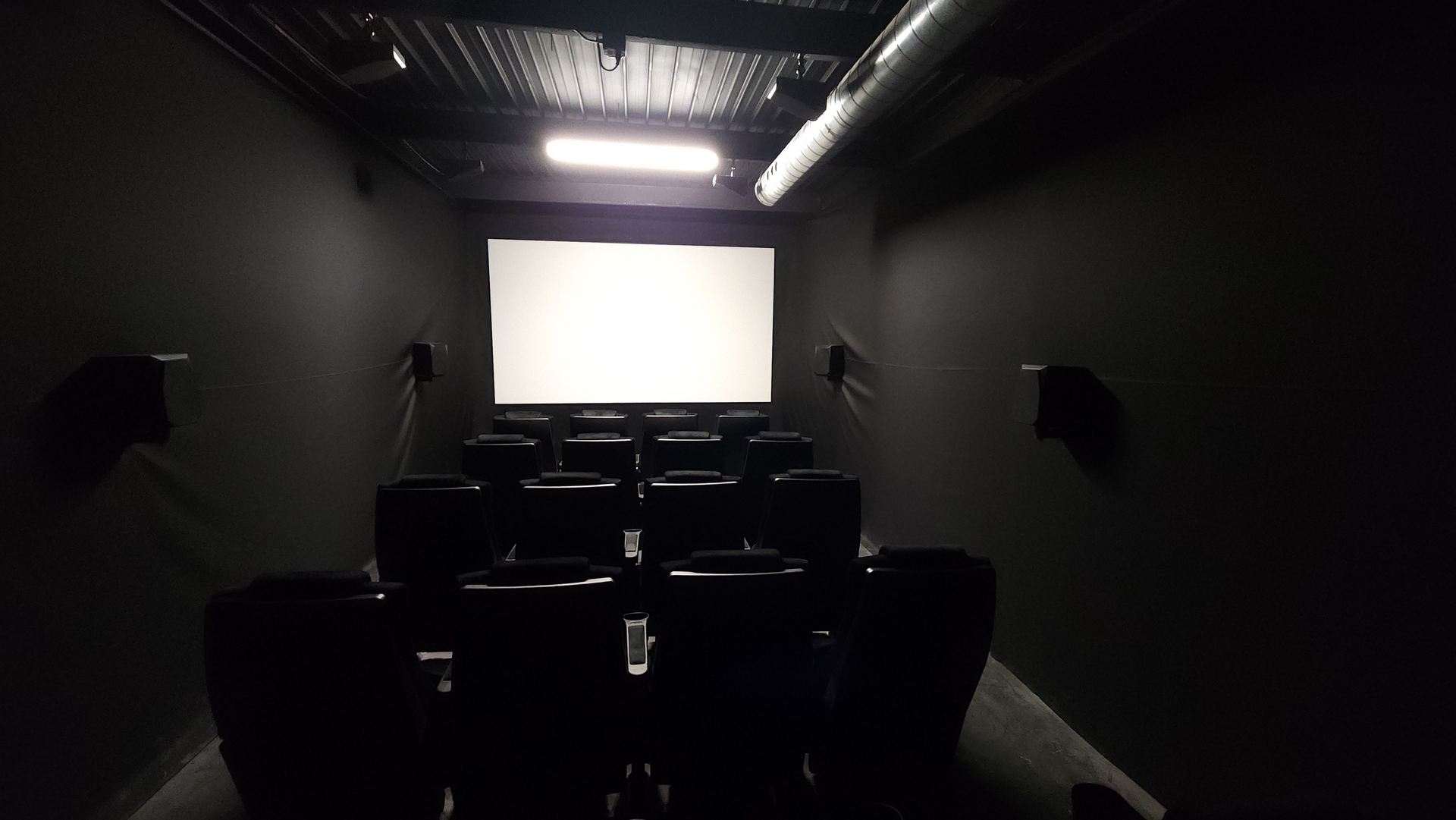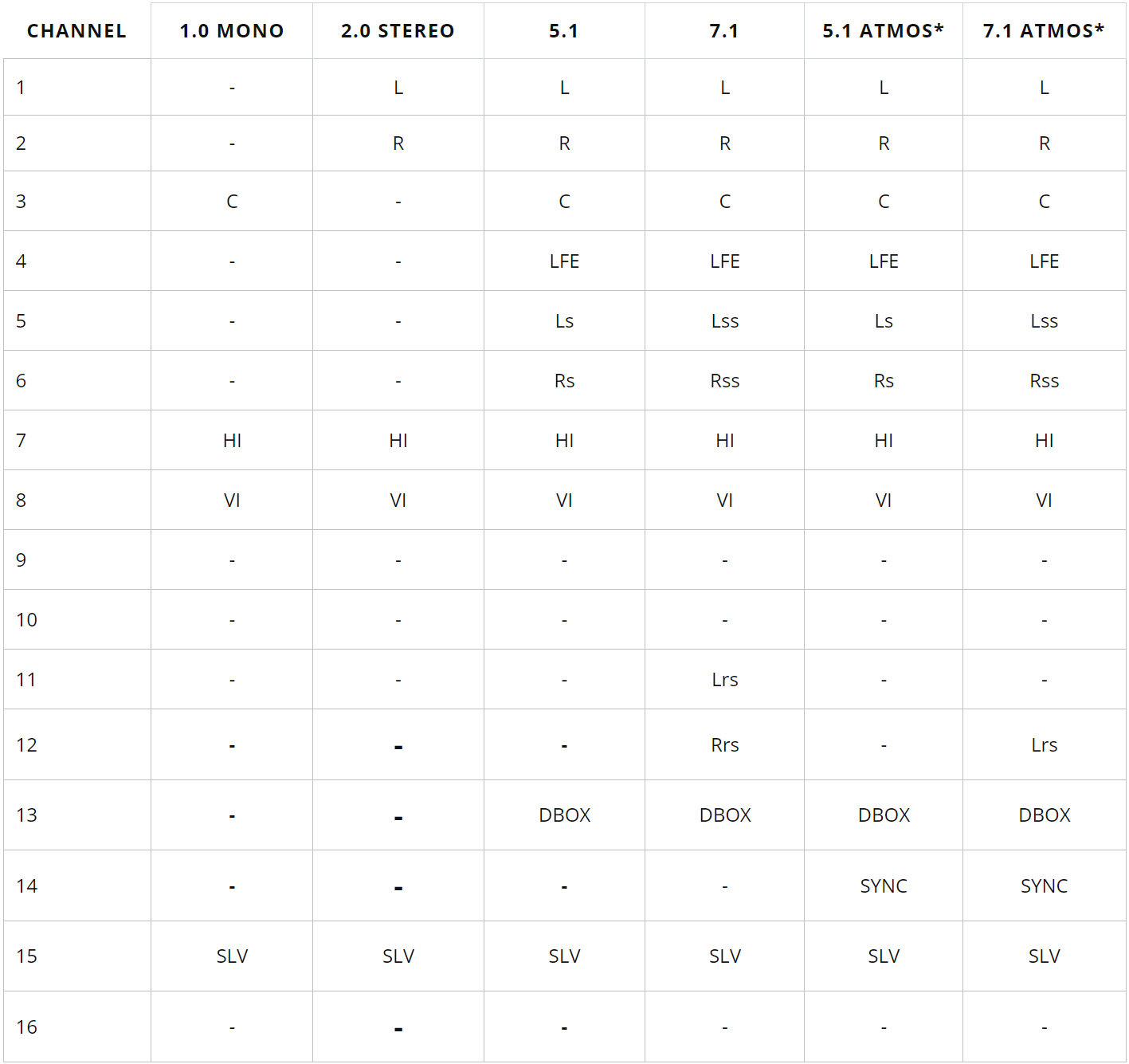
This is the global industry standard format for exhibiting films in cinemas.
When ready to submit your source material for conversion, please adhere to the following delivery specifications. Failure to do so can result in an inaccurate or low quality transfer and may incur additional time and/or cost to rectify. It is the filmmaker’s responsibility to check all source material thoroughly before delivery.
Quicktime/MXF/MP4
- ProRes (4444XQ, 4444, 422HQ, 422)
- DNxHR (444, HQX, HQ, SQ)
- DNxHD
- XDCAM-EX
- H.265/H.264
-- High Profile or Better
-- ≥ 20 Mbps for HD, ≥ 40Mbps for UHD
- Image Sequences
- DPX (3-channel interleaved RGB; 10-bpc)
- TIFF (3-channel interleaved RGB; 16-bpc)
- JPEG2000 (12-bpc unsigned)
LAT (1.85:1)
2K - 1998 X 1080
4K - 3996 X 2160
SCOPE (2.39:1)
2K - 2048 X 858
4K - 4096 X 1716
If your source material does not fit in one of the containers listed above, it will be letterboxed, pillarboxed, or resized to fit. We recommend delivering source material in one of these container resolutions to ensure accurate conversion. Please specify if the aspect ratio of your content changes during the course of film playback.
If delivering anamorphic content, a pixel aspect ratio must be specified when placing your order. DCI does not support anamorphic projection
All DCPs are conformed to industry standard DCI-P3 color space in XYZ’ target color gamut. In order to properly convert your source master for DCP, you must accurately identify the grade of your source material. Some common and acceptable grades are:
sRGB
Rec709 (gamma 2.2, 2.35, 2.4)
P3 DCI
P3 D65
All films where a color space is not given shall be assumed Rec709 gamma 2.2
All source materials should be delivered in an RGB target color gamut.
Only source materials color timed to P3 DCI color space will be accepted in XYZ’ target color gamut
DCI – Universal Compatibility
2K: 24
4K: 24
HFR(2K): 48
3D: 24
SMPTE – Modern/Specialty Formats
2K: 24,25,30
4K: 24,25,30
HFR(2K): 48,50,50
3D: 24
For maximum compatibility, DCPs should be mastered at 24 fps
SMPTE Bv2.1 compliance requires 24 or 25 fps playback
Framerates higher than 25 fps not supported on many systems. Check your theater for compatibility
All audio tracks should be delivered as Uncompressed 24-bit PCM audio at 48KHz. Muxed or compressed files including AC-3 or AAC will not be accepted.
Ref level = -20dBFS
Output level = 85dBc
Audio may be included in your video container (MOV, MXF, MP4) as long as it adheres to SMPTE standard channel assignments.
HI = Hearing Impaired Audio
VI = Visual Impaired Audio Description
SLV = Sign Language Video
*Dolby Atmos mix must be accompanied by auxiliary MXF track

It is recommended practice that all films exceeding 23 minutes in length be broken into reels. While it is possible to create a long play DCP, this will prove a limiting factor when working with your DCP in the future and may result in added time and expense.
If delivering in reels, each track must be broken into matching reels with the same formatting specifications and run time. For example, video elements delivered in reels may not be delivered with an audio print master delivered as a long play
Each reel should be provided with 8 seconds of Academy head and tail leader with accompanying head and tail pops matching audio.
It is highly recommended that the first and last frame of your composition should be a black frame in order to ensure proper transition between playlist items and to accomodate queuing up of content that is parked on pause during theatrical exhibition
Our focus at Notis Studios is in ensuring your timed text tracks meet the technical specifications necessary to play properly in commercial cinemas. It is the submitters responsibility to evaluate timed text tracks for spelling, formatting, and any other aesthetic considerations prior to submission. Please ensure that your timed text tracks are accurate and meet your standards prior to submission.
Notis Studios can implement subtitles and captions for both on-screen playback and auxiliary devices with support for both XML and PNG subtitling. Supply your subtitles in any of the following formats:
Captionmaker (cap)
DLP CineCanvas (xml)
DVD Studio Pro / Spruce STL (stl, doc, rtf, txt)
iTunes Timed Text (itt)
Subrip (srt)
SCC Closed Caption (scc, mov, m4v)
WebVTT (vtt)
All timed text elements must be at least 15 frames in duration and spaced at least 2 frames between each instance. Any given composition’s first timed text element must occur no less than 4 seconds from start of picture.
Open Subtitles and captions are timed text tracks that are intended to be played on screen in real time for all viewers. Please evaluate your subtitles closely to ensure that your text will display clearly and legibly during each timed text instance and that it will not interfere with any burned-in text elements such as lower thirds, location cards, subtitles, etc.
It is recommended that open subtitles/captions not exceed 52 characters per line, but must not exceed 79 characters per line.
Each open subtitle/caption instance should have a maximum of three lines
Closed Captions/Subtitles are timed text tracks that are intended to be played on auxiliary devices that do not interfere with the primary viewing experience. Closed captions/subtitles are subject to a number of technical restrictions that mandate several considerations for the packaging of your DCP. Failure to meet these prerequisites may result in additional processing time and fees for your order
Closed Captions/Subtitle XML files must not exceed 256KB in size. This corresponds to an average run time of around 20-25 minutes. Films longer than 23 minutes in length should, accordingly, be broken into reels with no reel exceeding 23 minutes in length prior to submission.
It is recommended that closed captions/subtitles not exceed 30 characters per line, but must not exceed 32 characters per line.
Each closed caption/subtitle instance should have a maximum of three lines
The Academy of Motion Picture Arts and Sciences maintains strict guideline as to how DCPs must be formatted to qualify for an Oscar nomination.
Client MUST indicate need for academy qualifying DCP
DCPs must be packaged in a SMPTE container
Minimum 3-channel (L/R/C) audio mix
HI – Hearing Impaired tracks
A hearing impaired audio track is a mono mix down of the film intended to assist viewers who have difficulty hearing dialogue and other sound elements in a movie theater.
The recommended method for providing such a track is to mix down the L/R/C channels of audio using the following formula:
Center Channel @ 0dB
Left Channel @ -6dB
Right Channel @ -6dB
Peak Limiter @ -14dBFS
Compressor @ 2.5:1
VI – Visually Impaired Descriptive Audio track
A visually impaired descriptive audio track is a mono narration track that describes the most pertinent details of what is taking place on screen to assist viewers who have difficulty seeing. These tracks can be recorded by professional narrators or procedurally built using a transcription service with text to speech technology.
VI tracks do not contain a full mixown of the film soundtrack. This is a narration only track.
SLV – Sign Language Video
Source Requirements:
Frame rate: 24 fps
Resolution: 480×640
Color: Y’UV
